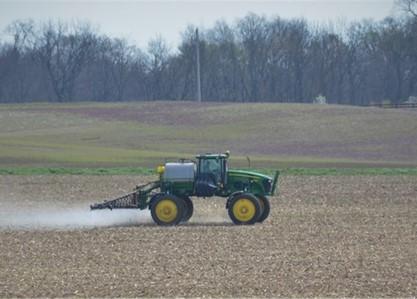Considerations for Burndown Programs in 2023
It’s that time of year when growers are considering which herbicides to include in their burndown programs. Utilizing effective herbicides will help to ensure less weed competition at planting. However, growers should consider not only what herbicides they plan to use in their burndown programs, but also the weed species present in the field.
The most common preplant treatment for both corn and soybean is either a combination of 2,4-D + glyphosate or dicamba + glyphosate. These mixtures can provide good to excellent control of winter annual weeds such as common chickweed and common groundsel, as well as good control of emerging summer annual species such as common lambsquarters and foxtail species. These herbicides can also control henbit, purple deadnettle, and mustard species if sprayed before flowering and seed set. However, control may be reduced with winter annual weeds such as Carolina geranium and field pansy, as well as perennial species such as curly dock. If Carolina geranium and field pansy are present, consider adding atrazine or metribuzin to the tank mix. If curly dock is a problem consider using Harmony + 2,4-D.
The use of these herbicides will also influence planting date if using non-tolerant varieties, such as Enlist® (2,4-D) and XtendFlex® (dicamba). Generic forms of 2,4-D or dicamba should be applied 7 to 14 days before or 3 to 5 days after planting corn. The planting interval for soybean will depend on the amount of product applied. For most generic 2,4-D esters (LVE), wait at least 7 days if using 1 pt/A and at least 30 days if using 2 pt/A. However, some LVE formulations allow a 15 day application interval, be sure to consult the product label for specific instructions. The planting interval for dicamba formulations is at least 14 days if 0.5 pt/A is applied and at least 28 days if 1 pt/A is applied.
Glyphosate resistant weeds such as horseweed (marestail) and common ragweed may also be present at the time of application. Be advised that when using combinations of glyphosate and 2,4-D or dicamba, the 2,4-D or dicamba component is being relied upon to control these weeds. Therefore, these species should be sprayed when they are small (< 6 in.). Local data has shown applications of 2,4-D or dicamba made 30 days before planting to be more effective on horseweed than applications made 14 days before planting. Sharpen® is another option for controlling horseweed that is less than 6 inches tall.
Finally, it is important to note the importance temperature will play in the efficacy of these herbicides. When the temperature is lower than 60˚F, weed growth slows, resulting in reduced uptake and translocation of systemic herbicides like 2,4-D, dicamba, and glyphosate. If the temperature is below 40˚F, it is best to avoid applying these herbicides until conditions are more suitable. Fortunately, it looks like warmer days are ahead!
